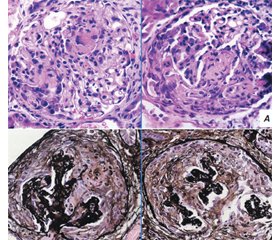Журнал «Почки» Том 12, №3, 2023
Вернуться к номеру
Швидкопрогресуючий гломерулонефрит і АНЦА-негативний pauci-імунний васкуліт: незвичайні прояви. Клінічний випадок
Авторы: Zitlali Guadalupe Paulín Zepeda, Louis Fernando Robles Fernandes, Vianey Guadalupe Tellez Bolaños, José Carlos Ortiz Diaz, María Inés Gil Arredondo
Centro Médico Nacional Siglo XXI, Mexican Institute of Social Security, Mexico City, Mexico
Рубрики: Нефрология
Разделы: Справочник специалиста
Версия для печати
Швидкопрогресуючий гломерулонефрит відповідає клінічному сценарію ураження клубочків, що включає швидке погіршення функції нирок різноманітної етіології. Серед цих випадків 85 % пов’язані з pauci-імунним васкулітом з антинейтрофільними цитоплазматичними антитілами (АНЦА). Однак решта підгрупи може мати негативні за АНЦА результати. Клінічні прояви часто включають зниження швидкості клубочкової фільтрації, що іноді вимагає замісної ниркової терапії, а також екстраренальні симптоми, такі як дифузна альвеолярна кровотеча. Діагноз підтверджують за допомогою біопсії нирки, негативного серологічного тесту на АНЦА та виключення іншої етіології. Згідно з міжнародними рекомендаціями з клінічної практики, рекомендоване лікування для обох захворювань є однаковим із додаванням замісної ниркової терапії, якщо необхідно. Проте прогноз, як правило, несприятливий із незначним відновленням функції нирок або без нього. Описано випадок АНЦА-негативного швидкопрогресуючого pauci-імунного гломерулонефриту в пацієнтки перших десятиліть життя.
Rapidly progressive glomerulonephritis corresponds to a clinical scenario of glomerular damage involving rapid deterioration of renal function with multiple etiologies. Within these, 85 % of cases are associated with pauci-immune vasculitis with antineutrophil cytoplasmic antibodies (ANCA). However, a remaining subgroup may present ANCA-negative results. The clinical presentation often involves a decline in the glomerular filtration rate, sometimes requiring renal replacement therapy, as well as extrarenal manifestations such as diffuse alveolar hemorrhage. Confirmatory diagnosis is achieved through renal biopsy, negative serology for ANCA, and exclusion of other etiologies. According to international clinical practice guidelines, the recommended treatment for both entities is the same, with the addition of renal replacement therapy if necessary. However, the prognosis tends to be unfavorable with little to no recovery of renal function. This case presents a female patient in the early decades of life with ANCA-negative, rapidly progressive, pauci-immune glomerulonephritis.
швидкопрогресуючий гломерулонефрит; pauci-імунний васкуліт; АНЦА-негативні результати
rapidly progressive glomerulonephritis; pauci-immune vasculitis; ANCA-negative results
Для ознакомления с полным содержанием статьи необходимо оформить подписку на журнал.
- Ramos J.M., Medina A.B., Fernández M.P. Glomerulonefritis agudas y rápidamente progresivas. Medicine. 2019. 12. 4717-4724. doi: 10.1016/j.med.2019.05.029.
- Chen M., Kallenberg C.G.M., Zhao M.-H. ANCA-negative pauci-immune crescentic glomerulonephritis. Nature Reviews Nephrology. 2009. 5(6). 313-318. doi: 10.1038/nrneph.2009.67.
- Jennette J.C., Nachman P.H. ANCA Glomerulonephritis and Vasculitis. Clin. J. Am. Soc. Nephrol. 2017 Oct 6. 12(10). 1680-1691. doi: 10.2215/CJN.02500317.
- Chen M. et al. Antineutrophil cytoplasmic autoantibody negative pauci-immune crescentic glomerulonephritis. J. Am. Soc. Nephrol. 2007. 18. 599-605.
- Kim M., Kim Y.U., Boo S.J., Kim S.M., Kim H.W. Antineutrophil cytoplasmic antibody-negative pauci-immune glomerulonephritis with massive intestinal bleeding. Kidney Research and Clinical Practice. 2015 Sep. 34(3). 180-4.
- Eisenberger U., Fakhouri F., Vanhille P., Beaufils H., Mahr A., Guillevin L. et al. ANCA-negative pauci-immune renal vasculitis: histology and outcome. Nephrology Dialysis Transplantation. 2005 Jul 1. 20(7). 1392-9.
- Moroni G., Ponticelli C. Rapidly progressive crescentic glomerulonephritis: early treatment is a must. Autoimmun. Rev. 2014 Jul. 13(7). 723-9. doi: 10.1016/j.autrev.2014.02.007.
- Sethi S., Zand L., De Vriese A.S., Specks U., Vrana J.A. et al. Complement activation in pauci-immune necrotizing and crescentic glomerulonephritis: results of a proteomic analysis. Nephrol. Dial. Transplant. 2017. 32 (suppl. 1). i139-i45. doi: 10.1093/ndt/gfw299.
- Rovin B.H., Adler S.G., Barratt J., Bridoux F., Burdge K.A. et al. KDIGO 2021 clinical practice guideline for the management of glomerular diseases. Kidney International. 2021. 100(4). doi: 10.1016/j.kint.2021.05.021.
- Parmar M.S., Bashir K. Crescentic Glomerulonephritis. In: StatPearls [Internet]. Treasure Island (FL): StatPearls Publishing; 2023 Jan.
- Jennette J.C., Thomas D.B. Pauci-immune and antineutrophil cytoplasmic autoantibody glomerulonephritis and vasculitis. In: Heptinstall’s Pathology of the Kidney. Ed. by Jennette J.C., Olson J.L., Schwartz M.M., Silva F.G. 6th ed. Philadelphia, Lippincott Williams & Wilkins; 2007. 643-674.
- Syed R., Rehman A., Valecha G., El-Sayegh S. Pauci-Immune Crescentic Glomerulonephritis: An ANCA-Associated Vasculitis. Biomed. Res. Int. 2015. 2015. 402826. doi: 10.1155/2015/402826.
- Shah S., Havill J., Rahman M.H., Geetha D. A historical study of American patients with anti-neutrophil cytoplasmic antibody negative pauci-immune glomerulonephritis. Clinical Rheumatology. 2015. 35(4). 953-960. doi: 10.1007/s10067-015-3086-8.
- Shu K.-H., Chiang W.-C., & Chiu Y.-L. Anti-CD20 therapy and pauci-immune crescentic glomerulonephritis. Journal of the Formosan Medical Association. 2017. 116(4). 215-216. doi: 10.1016/j.jfma.2015.12.003.

